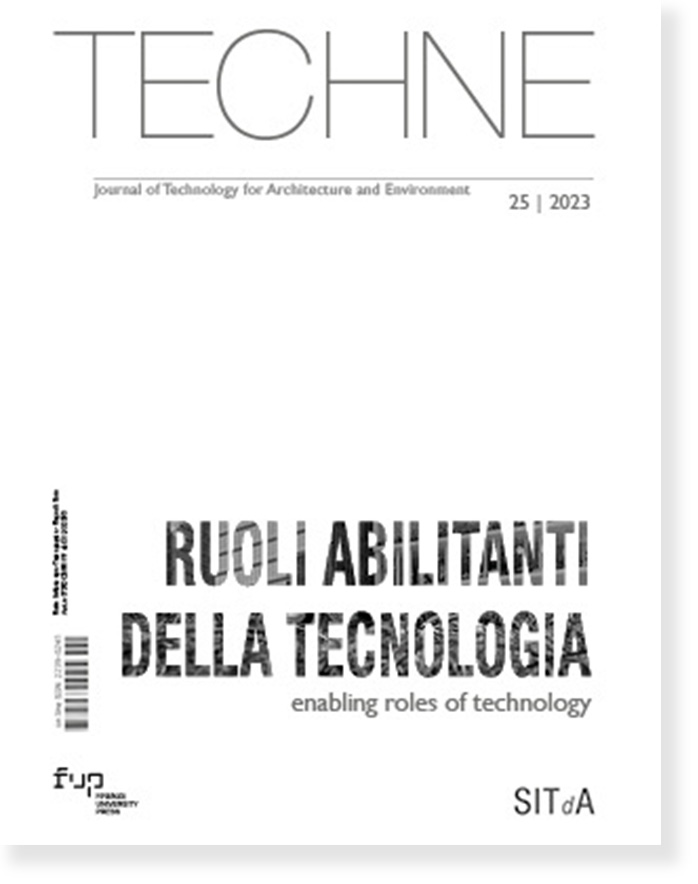Published 2023-05-30
Keywords
- Artificial intelligence,
- Decision-making,
- Architectural design,
- Technological innovation
How to Cite
Copyright (c) 2023 Tiziana Ferrante, Federica Romagnoli

This work is licensed under a Creative Commons Attribution 4.0 International License.
Abstract
The increasingly pervasive use of artificial intelligence within the complexity of the world around us continues to fuel the scientific, philosophical, and political debate. Even within the construction sector (although still in an embryonic phase), it is possible to observe the first concrete results of the application of new digital processes, which are increasingly autonomous and support the design, definition, and validation of the project. The new frontiers of expansion of artificial intelligence systems, encouraged by the digital transition, require a careful reflection on the impact of new technologies in redefining the designer’s role in the decision-making process.
Downloads
References
Buchanan, B.G. (2006), “A (Very) Brief History of Artificial Intelligence”, AI Magazine, Vol. 26, n.4.
Campioli, A. (2020), “Tecnologie e cultura del progetto nella società delle mangrovie”, in Perriccioli, M., Rigillo, M., Russo Ermolli, S., Tucci, F. (Eds.), Il Progetto nell’Era Digitale. Tecnologia Natura Cultura, Maggioli Editore, Santarcangelo di Romagna, pp. 68-70.
Castells, M. (1996), The Rise of the Network Society, The Information Age: Economy, Society and Culture, Vol. I., Blackwell Publishers, Cambridge.
Christodoulou, A., Vola, M. and Rikken, G. (2018), “Case Study for the Application of Multidisciplinary Computational Design Assessment and Constructability Optimisation Tools”, Proceedings of the Symposium on Simulation for Architecture and Urban Design, (SimAUD ’18), Delft, June 4-7, 2018, Society for Computer Simulation International, San Diego, CA, pp. 1-8.
Ciribini, G. (1984), Tecnologia e progetto: Argomenti di cultura tecnologica della progettazione, CELID, Torino.
Crawford, K. (2021), Atlas of Ai: Power, Politics, and the Planetary Costs of Artificial Intelligence, Yale University Press, New Haven.
Cross, N. (1999), "Natural Intelligence in Design", Design Studies, Vol. 20, n.1, pp. 25-39.
Damasio, A. (2022), Sentire e conoscere. Storia delle menti coscienti, 2nd ed., Adelphi, Milano.
Debney, P. et al. (2022), “Advanced Applications in Computational Design”, in: Bolpagni, M., Gavina, R., Ribeiro, D. (Eds.), Industry 4.0 for the Built Environment. Structural Integrity, Vol. 20, Springer, Cham, pp. 77-102.
European Construction Sector Observatory (ECSO) (2021), Digitalisation in the construction sector
European Commission (2020), European enterprise survey on the use of technologies based on artificial intelligence: final report, Publications Office, available at: https://data.europa.eu/doi/10.2759/759368 (accessed 24 August 2022)
European Construction Technology Platform (ECPT) (2018), Artificial Intelligence - Research and Innovation Needs Manufacturing, Energy Intensive Industries, Bio-Based Industries and Construction - Focus on the Construction and Built Environment Sector.
Ferrante, T. (2020), “Technological design and social innovation”, in Lauria, M., Mussinelli, E., Tucci, F. (Eds.), Producing Project, Maggioli Editore, Santarcangelo di Romagna, pp. 368-373.
Goodfellow, I. et al. (2014), “Generative Adversarial Nets”, Proceedings of the International Conference on Neural Information Processing Systems, NIPS 2014, pp. 2672–2680.
Kelly, N., and Gero, J. (2021), “Design thinking and computational thinking: A dual process model for addressing design problems”, Design Science, Cambridge University Press, Vol. 7, p.e8.
Kurzweil, R. (2006), The Singularity Is Near: When Humans Transcend Biology, Penguin Books, London.
Leach, N. (2021), Architecture in the Age of Artificial Intelligence, Bloomsbury Publishing, London.
Parisi, G. (2021), In un volo di storni, Rizzoli Libri, Segrate.
Pearl, J., and Mackenzie, D. (2018), The Book of Why: The New Science of Cause and Effect, Basic Books, New York.
Rittel, H.W., and Webber, M.M. (1973), “Dilemmas in a general theory of planning”, Policy Sciences, Vol. 4, n.2, pp. 155–169.
Russo Ermolli, S. (2020), The digital culture of architecture. Note sul cambiamento cognitivo e tecnico tra continuità e rottura-Notes on cognitive and technical change between continuity and disruption, Maggioli Editore, Santarcangelo di Romagna.
Simon, H.A. (1996), The Sciences of the Artificial, 3rd ed., MIT Press, Cambridge, Massachusetts.
Tegmark, M. (2018), Life 3.0: Being Human in the Age of Artificial Intelligence, Penguin Books, London.
Wing, J. (2006), “Computational thinking”, Communications of the ACM, vol. 49, n. 3, pp.33-35.






